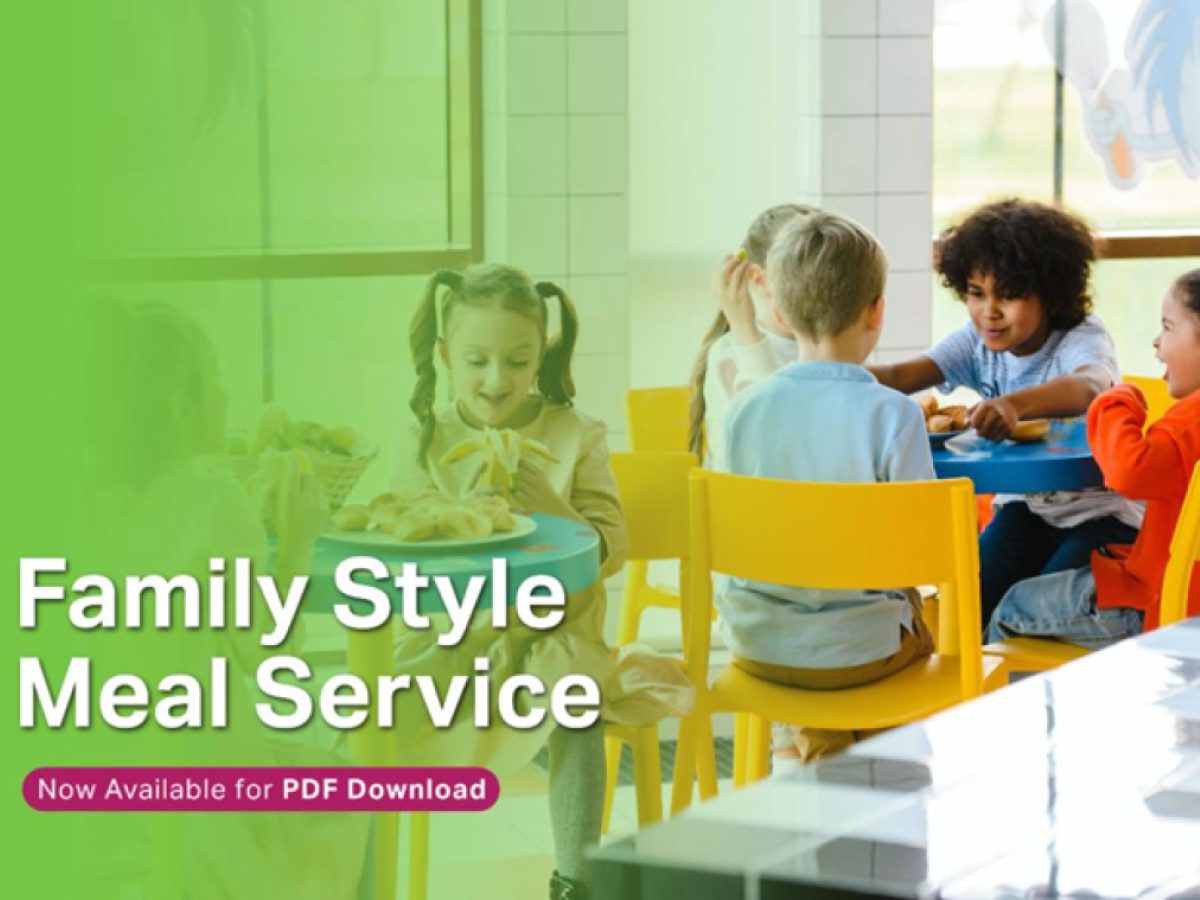Family Style Meal Service
Institute of Child Nutrition (ICN)
February 6, 2024

Family Style Meal Service (FSMS) is a way to enhance the enjoyment of mealtime in the child care setting. It not only benefits the children, but the child care program as well. FSMS encourages a pleasant eating environment that promotes mealtime as a learning experience. This Mealtime Memo by our partners at the Institute of Child Nutrition reviews the benefits of FSMS and provides tips to implement it successfully.
Family Style Meal Service Basics
Family style meal service is a type of meal service where adults and children sit at the same table, eating together while sharing pleasant conversations. People pass food to one another from common serving dishes and children serve themselves what they would like to eat and how much.
To ensure a positive mealtime experience, adults should:
- Place all food in serving bowls on the table.
- Provide enough food for each child to take the full CACFP serving size, as well as adults who are eating with the children.
- Pour all beverages into child-sized pitchers and place them on the table.
- Engage in meaningful conversations with children.
- Encourage, but not require, children to take all components in the minimum serving size.
- Assist children when needed.
- Model eating, give guidance on serving sizes, and listen to hunger and fullness cues.
- Allow children to take second portions if desired.
Benefits of Family Style Meal Service for Children
Participating in FSMS provides skills that reinforce learning and development, increase vocabulary, encourage social interactions with others, create feelings of independence, and instill lifelong healthy habits. Let’s take a closer look at the benefits.
Social Skills
Children have the chance to learn and practice social skills. Saying “please” and “thank you,” waiting their turn, and sharing the group meal are learned social skills. Engaging in conversation during the meal with others supports social development.
Motor Skills
When children pass a bowl or put food on their plate, they are learning and practicing self-serve skills that will expand both gross and fine motor skills. Keep in mind that children develop at individual rates and may be at different skill levels. Younger children may need more help learning self-serve skills. Help them by providing child-sized utensils that are easier to maneuver and foods that are easy to scoop or handle.
Tips for Developing Self-Serve Skills
Before implementing FSMS, adults should model actions and children should practice the following skills.
Set up stations to learn how to:
- Pass serving dishes with both hands and keeping fingers out of the food.
- Use various serving utensils: scoops, tongs, and short-handled serving spoons.
- Pour beverages by pretend pouring “dry liquids” such as sand in play areas, and water over a large sink or water table.
Transition skills to meal and snack time by:
- Pouring beverages into child-size cups, with assistance as needed.
- Cleaning up their eating area by putting their used dishes in a designated area.
- Wiping a table or a spill with a sponge, paper towel, or cloth.
- Cleaning up after each meal and snack.
Food Safety
FSMS teaches children food safety, which will help reinforce healthy behaviors they will use in the future. The following are some food safety practices children may learn.
- Washing hands before mealtime
- Keeping fingers out of the food in the serving dishes while passing food
- Using serving utensils for service and personal utensils for eating
- Cleaning up spills correctly and using it as a positive learning experience
Autonomy of Food Choice
According to the Satter Feeding Dynamics Model, when children control food choices and portion sizes, they can regulate food intake and learn to eat a variety of food. Watching others take unfamiliar food encourages reluctant tasters to try something new. The choice of taking a small amount of food initially with the option of taking more later empowers children to expand their food choices. Adults should encourage but never force taking or tasting food. All these benefits can enhance self-confidence in children. They see all the different things they CAN do.
Benefits of Family Style Meal Service for Child Care Programs
Child care programs benefit from FSMS too! Once children learn roles for FSMS, the work is shared, and mealtime may be calmer. Adults should sit during mealtimes and model positive habits such as table talk, trying foods, and general meal enjoyment.
Tips for Implementing Family Style Meal Service
Implementing FSMS takes planning, practice, and preparation. Create a plan by:
- Training all employees on FSMS
- Planning enough time to implement
- Providing plenty of skill-building for children
- Purchasing child-size serving bowls, platters, and serving utensils for each table
- Considering gradual implementation
- Being patient as this will be a learning experience for children
- Informing families about FSMS and encouraging FSMS at home
For more tips and resources, read ICN’s February Mealtime Memo. Also, don’t miss NCA’s webinar on Family Style Dining: Conversations Around the Table.
